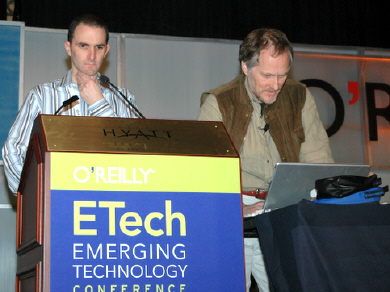ETech: Attenuation, Web 2.0 and spimes

Rael Dornfest and Tim O’Reilly opened their Emerging Technology Conference in San Diego tonight talking about what’s on their radar scope—looking at key tech trends that are shaping the future, “identifying small pieces yet to be loosely joined in the future,” Dornfest said.
One problem today is there are too many loosely joined little pieces. The alpha geeks life is one in which no moment offline goes unpunished, Dornfest quipped. Aggregation holds great promise, but it’s still too primitive, not much more elegant than shifting data from one inbox to another. “RSS aggregators were supposed take care of problem, but they don’t tell you what to read…they just give you more,” Dornfest said and the audience of over 1,000 concurred.
Dornfest’s has come up with a new twist on the so-called attention economy-- ‘attenuation’ [the act of making thin or less dense, or of rarefying, as fluids or gases] is the next aggregation. “There will be fewer features and interruptions. Great businesses will be built on giving you less,” he said. And, you’ll get most of it for free.
Giving us less means getting the stuff you really want or need in a given context. In addition to RSS (Really Simple Syndication), we need RGF (Really Good Filtering), not more social networking sites.

Rael Dornfest and Tim O'Reilly prep for the opening of ETech
O'Reilly laid out the filters through which he views technology:
Technology is on track with a long term trends--for example everything becoming networked
Technology is disruptive--such as the Internet
Technology uptake is accelerating
Technology has grassroots support—it’s bottom up
It inspires passion--such as P2P
It has deeper social implications
Better information makes a difference in its adoption and use
He also discussed the problem of looking at new trends, but rooting then in old paradigms. We tend to look at Linux versus Windows rather than focusing on the fact the Google and others have built disruptive business on top of Linux. O’Reilly went on to say that the applications that matter are “truly networked citizens.” He goes on to say: “The key competitive advantage is in having figured out how to get users to create the value.”
O'Reilly reprised his well traveled definition of Web 2.0, and contended that have "people inside the machine is something we have to start getting used to." A tag cloud, for example, is derived from interaction of people who use the applications, he said. "Users are part of value being delivered." He mentioned boxxet, which users machine automation and community participation to pull together content (blogs, photos, gear, services, etc.) subjects, such as sports teams, TV shows and schools. The site is currently invitation only. Human participation is amplified by machine automation, said boxxet founder You Mon Tsang on his blog. O'Reilly quotes George Dyson about making computers intelligence because we are part of them and connected to them. O'Reilly winds up with hacking the physical world (RFID and more), voice controlled blenders, a promo for Make and a demo of Zimbra's slick Zimlet mashup with Asterisk open source PBX software. Then he warned the crowd about paying attention to interoperability. "If we don't do it well, it could open the door to another monopoly player who says 'we'll make it all work.' "
O'Reilly was followed by the brilliant and provocative Bruce Sterling.
The highly regarded science fiction writer and 'futurist' riffed on the Internet of Things; spimes; his book Shaping Things,; recylcing; ordinateurs; linking, ranking, tagging, sorting machines; AI as a good example of freezing language too early; virtual design and fabjects; verbal framing devices and attention pointers; Web 2.0 as a technology lash up; and how words, not just circuitry, really matters in the tech world (you don’t want to avoid contentiousness of definitional struggles, he said). You had to be there. Bruce said he would have his speech on line later this week (I will point to it), but hopefully the video or audio will be available.
Scott Rosenberg has a good post on Sterling's ETech talk.